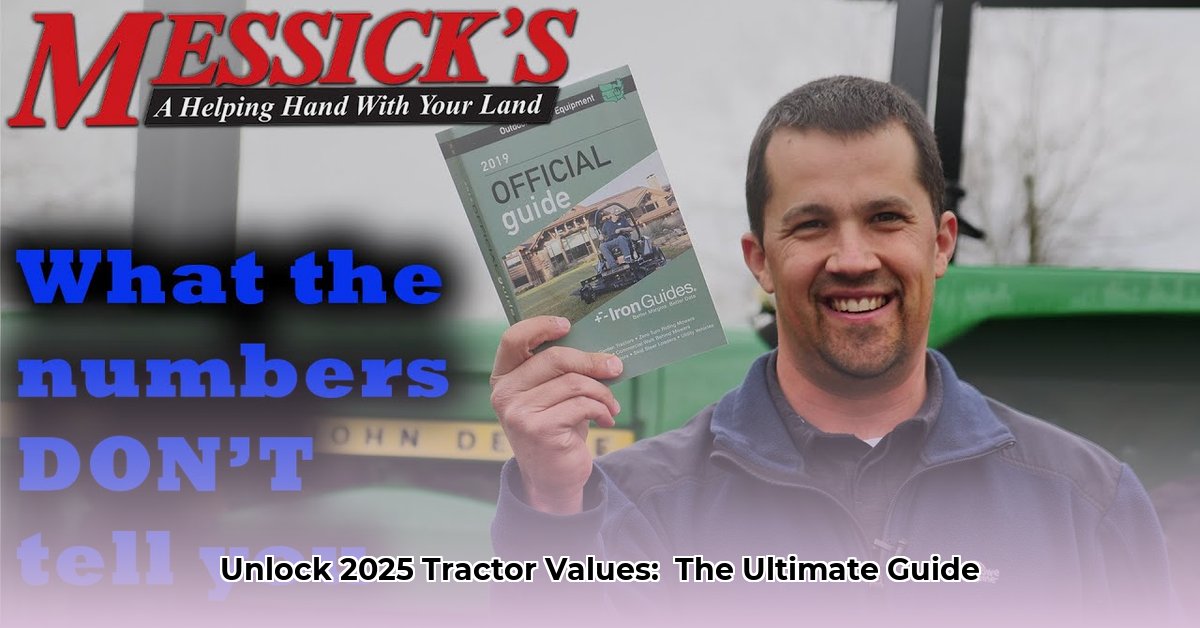
Finding the right used tractor can be challenging, especially without a readily available resource like a Kelley Blue Book for tractors. But don't worry! This guide provides a straightforward approach to finding a fair price and ensuring you make a smart purchase. We'll cover everything from researching prices to conducting a thorough pre-purchase inspection. Saving money on a used tractor is entirely achievable with the right knowledge and strategy. For additional valuation help, check out this tractor value resource.
Factors Affecting Used Tractor Value: More Than Just Age
Several key factors influence a used tractor's value. It's not just about age; condition, operating hours, and technology all play a significant role. Think of it as a recipe—each ingredient affects the final dish.
Condition (40% Impact): A well-maintained tractor, free of significant rust, dents, or damage, commands a higher price. Imagine it like buying a used car—a clean history adds value.
Hours of Operation (30% Impact): Fewer operating hours generally mean less wear and tear on the engine, transmission, and hydraulic systems. Lower hours frequently translate to a higher price. How many hours are acceptable for your needs?
Maintenance History (15% Impact): Comprehensive maintenance records show diligent care, reducing the risk of hidden problems. Detailed records inspire confidence in a potential buyer. Do you have access to the previous owner’s maintenance log?
Technology (10% Impact): Modern tractors often include GPS guidance, advanced engine management, and other technological features. These upgrades can significantly increase the asking price. Do these upgrades justify the increase in cost for your operation?
Location (5% Impact): Geographic location influences pricing due to local supply and demand. Prices can vary across regions because of market forces. What are the prevailing prices in your local area?
Here’s a visual representation of the percentage influence of each factor:
| Factor | Percentage Influence on Price |
|---|---|
| Condition | 40% |
| Hours of Operation | 30% |
| Maintenance History | 15% |
| Technology | 10% |
| Location | 5% |
Finding Fair Market Value: Your Research Roadmap
The absence of a Kelley Blue Book equivalent for tractors necessitates thorough research. Fortunately, several resources can help you determine a fair market value.
Step 1: Online Market Research: Explore online marketplaces and auction sites specializing in agricultural equipment. These platforms often list "sold prices," providing a realistic picture of current market values. How many similar tractors have recently sold in your area?
Step 2: Comparative Analysis: Compare similar models with comparable hours, condition, and technology. It's crucial to compare "apples to apples." What are the key features you want, and which ones are negotiable?
Step 3: Account for Variations: Remember that condition, hours, and technology are not standardized. Minor cosmetic issues should not heavily impact the price; however, major mechanical issues justify a significant price reduction. How do you weigh the importance of each factor?
Pre-Purchase Inspection: Your Critical Due Diligence
A thorough pre-purchase inspection is paramount. This step could save you from costly repairs down the line. Consider hiring a qualified mechanic specializing in agricultural equipment. Will the peace of mind and reduction in risk justify the cost of hiring a professional inspector?
Inspection Checklist:
Engine: Check for unusual noises, inspect fluid levels (oil, coolant, transmission fluid), and look for leaks.
Hydraulics: Test all functions (lift arms, power steering, implements) and check for leaks or sluggishness.
Transmission: Ensure smooth shifting and absence of grinding or whining noises.
Electrical System: Test all lights, gauges, and electrical components.
Tires: Inspect for wear, cracks, and proper inflation.
Frame and Structure: Check for damage, alignment issues, and rust.
Negotiation Strategies: Getting the Best Price
Armed with your research and inspection findings, you're ready to negotiate.
Know Your Limits: Determine your maximum price before negotiations begin.
Start Reasonably: Begin your offer slightly below your target price, allowing room for negotiation.
Use Your Evidence: Highlight any identified problems during the inspection.
Be Ready to Walk Away: Don't become emotionally attached; other tractors are available.
Financing and Insurance: Protecting Your Investment
Securing financing and insurance is crucial. Shop around for competitive loan rates and insurance policies that offer adequate coverage. How will you finance your purchase, and what level of insurance coverage do you require?
Risk Management: Mitigating Potential Issues
Buying a used tractor always involves risks, but these can be mitigated.
Mechanical Failure: Consider a service contract or extended warranty.
Hidden Problems: A thorough pre-purchase inspection is crucial.
Parts Scarcity: Research part availability and cost for the specific model.
Technological Obsolescence: Consider the cost and necessity of modern features.
Market Fluctuations: Monitor market trends to stay informed about price changes.
Conclusion: Your Path to a Successful Purchase
Buying a used tractor requires careful planning, research, and a pre-purchase inspection. By following these steps, you increase your chances of securing a reliable and well-priced machine that meets your requirements. Remember, diligent preparation is key to a successful and cost-effective acquisition.
Resources
- Machinery Pete
- Fastline (Example - replace with relevant resources)
- Your local agricultural equipment dealer (Example - replace with a relevant link for your region)